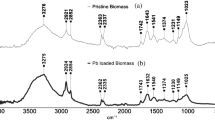Abstract
The kinetics and mechanism of lead biosorption by powderized Rhizopus oligosporus were studied using shake flask experiment. The optimum biomass concentration and initial solution pH for lead sorption at initial lead concentrations ranging from 50–200 mg/l was obtained at 0.5 g/l and pH5, respectively. In term of the ratio of initial lead concentration to biomass concentration ratio, the highest lead adsorption was obtained at 750 mg/g which gave the maximum lead uptake capacity of 126 mg/g. The experimental data of lead sorption by R.oligosporus fitted well to the Langmuir sorption isotherm model, indicating that the sorption was similar to that for an ion-exchange resin. This means that the sorption is a single layer metal adsorption that occurred as a molecular surface coverage. This assumption was confirmed by the examination of lead sorption using transmission electron microscope and energy dispersive X-ray analysis, which showed that during sorption most of the lead was adsorbed on the surface of cell.
Similar content being viewed by others
References
Akzu, Z. & Kutsal, T. 1991 A bioseparation process for removing lead (II) ions from waste water by using Chlorella vulgaris. Journal of Chemical Technology and Biotechnology 52, 109–118.
Andreas, L., Zdenek, R.H. & Volesky, B. 1995 Biosorption of heavy metals (Cd, Cu, N, Pb, Zn) by chemically reinforced marine algae. Journal of Chemical Technology and Biotechnology 62, 279–288.
Brady, D., Stoll, A.D., Starke, L. & Duncan, J.R. 1994 Chemical and enzymatic extraction of heavy metal binding polymers from isolated cell walls of Saccharomyces cerevisae. Biotechnology and Bioengineering 44, 297–302.
Brierly, JA., Goyak, G.M. & Brierly, C.L. 1986 Consideration for commercial use of natural product for metal recovery. In Immobilisation of Ions by Bio-sorption. eds. H. Eccles & S. Hunt, pp. 105–117, Chichester, England: Ellis Horwood. ISBN 0–74580003–3.
Brown, M.J. 1991 Metal recovery and processing. In Biotechnology, The Science and the Business. eds. V. Moses & R.E. Cape, pp. 567–579. Switzerland: Harvard Academic Publishers. ISBN 3–71865111–4.
de Rome, L. & Gadd, G.M. 1987 Copper adsorption by Rhizopus arrhizus, Cladosporium resinae and Penicillium italicum. Applied Microbiology and Biotechnology 26, 84–90.
Fourest, E. & Roux, J. 1992 Heavy metals biosorption by fungal mycelial by-product: Mechanisms and influence of pH. Applied Microbiology and Biotechnology 37, 399–403.
Friis, N. & Keith, M.P. 1986 Biosorption of uranium and lead by Streptomyces longwoodensis. Biotechnology and Bioengineering 28, 21–28.
Heldwein, R., Tombala, H.W. & Broda, E. 1977 Aufnahme von cobalt, blei and cadmium durch bakķerieën Zeitschrift für Allgemeine Mikrobiologie 17, 229–234.
Holan, Z.R., Volesky, B. & Prasetyo, I. 1993 Biosorption of cadmium by biomass of marine algae. Biotechnology and Bioengineering 41, 819–825.
Kim, Y.H., Yoo, Y.J. & Lee, H.Y. 1995 Characteristics of lead adsorption by Undaria pinnatifida. Biotechnology Letters 17, 345–350.
Kuyucak, N. & Volesky, B. 1989 The mechanism of cobalt biosorption. Biotechnology and Bioengineering 33, 823–831.
Lopez, F.A., Perez, C., Sainz, E. & Alonso, M. 1995 Adsorption of Pb2+ on blast furnace sludge. Journal of Chemical Technology and Biotechnology 62, 200–206.
Macaskie, L.E., Dean, C.R., Cheetham, A.K., Jakeman, J.B. & Skarnulis, A.J. 1987 Cadmium accumulation by a Citrobacter sp.: The chemical nature of the accumulated metal precipitate and its location on the bacterial cells. Journal of General Microbiology 133, 539–544.
Niu H., Xu, X.S. & Wang, J.H. 1993 Removal of lead from aqueous solutions by Penicillium Biomass. Biotechnology and Bioengineering 42, 785–787.
Peng. T.Y. & Koon, T.W. 1993 Biosorption of cadmium and copper by Saccharomyces cerevisae. Microbial Utilization Renewable Resources 8, 494–504.
Schumate, S.E., Strandberg, G.W. & Parrot, I. 1995 Biological removal of metal ions from aqueous process streams. Applied Microbiology and Biotechnology 42, 807–811.
Shurtle., W. & Aoyagi, A. 1979 The book of tempeh. New York: Harper and Row Publishers.
Scott, J.A. & Palmer, S.J. 1990 Sites of cadmium uptake in bacteria used for biosorption. Applied Microbiology and Biotechnology 33, 221–225.
Tobin, J.M., Cooper, D.G. & Neufeld, R.J. 1990 Investigation of the mechanism of metal uptake by denatured Rhizopus arrhizus biomass. Enzyme and Microbial Technology 12, 591–595.
Tsezos, M. & Volesky, B. 1981 Biosorption of uranium and thorium. Biotechnology and Bioengineering 23, 583–604.
Veglio, F., Beolchini, F. & Gasbarro, A. 1997 Biosorption of toxic metals: an equilibrium study using free cells of Anthrobacter sp. Process Biochemistry 32, 99–105.
Volesky, B. 1992 Removal of heavy metals by biosorption. In Harnessing Biotechnology for the 21st Century. Proceeding of the Ninth International Biotechnology Symposium and Exposition. eds. M.R. Ladisch & A. Bose, Washington, DC: American Chemical Society. ISBN 0–84122477–3.
Volesky, B. 1990 Removal and recovery of heavy metals by biosorption. In Biosorption of Heavy Metals ed. B. Volesky, Boca Raton, Florida: CRC Press Inc. ISBN 0–84934917–6.
Wehreim, B. & Wettern, M. 1994 Biosorption of cadmium, copper and lead by isolated mother cell walls and whole cells of Chlorella fusca. Applied Microbiology and Biotechnology 49, 331–343.
Xue, H.B., Stumm, W. & Sigg, L. 1988 The binding of heavy metals to algal surfaces. Water Research 22, 917–926.
Author information
Authors and Affiliations
Rights and permissions
About this article
Cite this article
Ariff, A., Mel, M., Hasan, M. et al. The kinetics and mechanism of lead (II) biosorptionby powderized Rhizopus oligosporus. World Journal of Microbiology and Biotechnology 15, 291–298 (1999). https://doi.org/10.1023/A:1008995026987
Issue Date:
DOI: https://doi.org/10.1023/A:1008995026987




